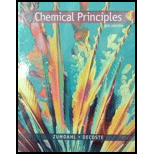
Interpretation:
The value of
Concept Introduction:
At standard states, the free energy charge which is responsible for the production of 1 mole of a molecule from its elements is known as standard free energy of formation and it is represented by
If the value of
The mathematical expression for
Where, n and p represents the coefficients of reactants and products in the balanced chemical equation.
Answer to Problem 61E
For first reaction:
For second reaction:
Second reaction is preferred over first reaction.
Temperatures below 622 K, reaction will be spontaneous
Explanation of Solution
The given reactions are:
For first reaction:
The mathematical expression for the standard free energy at room temperature is:
The value of standard free energy for
The value of standard free energy for
The value of standard free energy for
Put the values,
The mathematical expression for the standard entropy at room temperature is:
The value of standard entropy for
The value of standard entropy for
The value of standard entropy for
Put the values,
The mathematical expression for the standard enthalpy at room temperature is:
The value of standard enthalpy for
The value of standard enthalpy for
The value of standard enthalpy for
Put the values,
For second reaction:
The mathematical expression for the standard free energy at room temperature is:
The value of standard free energy for
The value of standard free energy for
The value of standard free energy for
Put the values,
The mathematical expression for the standard entropy at room temperature is:
The value of standard entropy for
The value of standard entropy for
The value of standard entropy for
Put the values,
The mathematical expression for the standard enthalpy at room temperature is:
The value of standard enthalpy for
The value of standard enthalpy for
The value of standard enthalpy for
Put the values,
On the basis of above calculation, second reaction is preferred over first reaction as the value of change in Gibbs free energy is negative that is
Now, for calculating temperature:
Reaction is spontaneous at low temperatures and change in enthalpy favors the production of acetic acid which is exothermic implies
Therefore,
Put the values from second reaction,
=
Therefore, at temperatures lower than 622 K, the magnitude of
Want to see more full solutions like this?
Chapter 10 Solutions
CHEM.PRINC.W/OWL2+REBATE+2 SUPPL.>IP<
- Consider the reaction of 1 mol H2(g) at 25C and 1 atm with 1 mol Br2(l) at the same temperature and pressure to produce gaseous HBr at these conditions. If this reaction is run in a controlled way to generate work, what is the maximum useful work that can be obtained? How much entropy is produced in this case?arrow_forwardThe free energy for a reaction decreases as temperature increases. Explain how this observation is used to determine the sign of either H or S.arrow_forwarda Calculate K1, at 25C for sulfurous acid: H2SO3(aq)H+(aq)+HSO3(aq) b Which thermodynamic factor is the most significant in accounting for the fact that sulfurous acid is a weak acid? Why?arrow_forward
- Use the data in Appendix G to calculate the standard entropy change for H2(g) + CuO(s) H2O() + Cu(s)arrow_forwardThe combustion of acetylene, C2H2, is a spontaneous reaction given by the equation 2C2H2(g)+5O2(g)4CO2(g)+2H2O(l) As expected for a combustion, the reaction is exothermic. What is the sign of H? What do you expect for the sign of S? Explain the spontaneity of the reaction in terms of the enthalpy and entropy changes.arrow_forwardCalculate H and G for the following reactions at 25C, using thermodynamic data from Appendix C; interpret the signs of H and G. a 2PbO(s)+N2(g)2Pb(s)+2NO(g)\ b CS2(l)+2H2O(l)CO2(g)+2H2S(g)arrow_forward
- Calculate H and G for the following reactions at 25C, using thermodynamic data from Appendix C; interpret the signs of H and G. a Al2O3(s)+2Fe(s)Fe2O3(s)+2Al(s) b COCl2(g)+H2O(l)CO2(g)+2HCl(g)arrow_forwardFrom the values for G f given in Appendix 1, calculate G at 25C for each of the reactions in Question 19.arrow_forward
 Chemistry: Principles and PracticeChemistryISBN:9780534420123Author:Daniel L. Reger, Scott R. Goode, David W. Ball, Edward MercerPublisher:Cengage Learning
Chemistry: Principles and PracticeChemistryISBN:9780534420123Author:Daniel L. Reger, Scott R. Goode, David W. Ball, Edward MercerPublisher:Cengage Learning General Chemistry - Standalone book (MindTap Cour...ChemistryISBN:9781305580343Author:Steven D. Gammon, Ebbing, Darrell Ebbing, Steven D., Darrell; Gammon, Darrell Ebbing; Steven D. Gammon, Darrell D.; Gammon, Ebbing; Steven D. Gammon; DarrellPublisher:Cengage Learning
General Chemistry - Standalone book (MindTap Cour...ChemistryISBN:9781305580343Author:Steven D. Gammon, Ebbing, Darrell Ebbing, Steven D., Darrell; Gammon, Darrell Ebbing; Steven D. Gammon, Darrell D.; Gammon, Ebbing; Steven D. Gammon; DarrellPublisher:Cengage Learning Chemistry: The Molecular ScienceChemistryISBN:9781285199047Author:John W. Moore, Conrad L. StanitskiPublisher:Cengage Learning
Chemistry: The Molecular ScienceChemistryISBN:9781285199047Author:John W. Moore, Conrad L. StanitskiPublisher:Cengage Learning Chemistry & Chemical ReactivityChemistryISBN:9781337399074Author:John C. Kotz, Paul M. Treichel, John Townsend, David TreichelPublisher:Cengage Learning
Chemistry & Chemical ReactivityChemistryISBN:9781337399074Author:John C. Kotz, Paul M. Treichel, John Townsend, David TreichelPublisher:Cengage Learning Chemistry & Chemical ReactivityChemistryISBN:9781133949640Author:John C. Kotz, Paul M. Treichel, John Townsend, David TreichelPublisher:Cengage Learning
Chemistry & Chemical ReactivityChemistryISBN:9781133949640Author:John C. Kotz, Paul M. Treichel, John Townsend, David TreichelPublisher:Cengage Learning ChemistryChemistryISBN:9781305957404Author:Steven S. Zumdahl, Susan A. Zumdahl, Donald J. DeCostePublisher:Cengage Learning
ChemistryChemistryISBN:9781305957404Author:Steven S. Zumdahl, Susan A. Zumdahl, Donald J. DeCostePublisher:Cengage Learning





